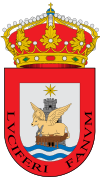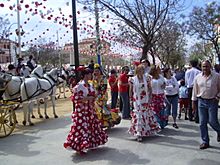Sanlúcar de Barrameda facts for kids
Quick facts for kids
Sanlúcar de Barrameda
|
|||
|---|---|---|---|
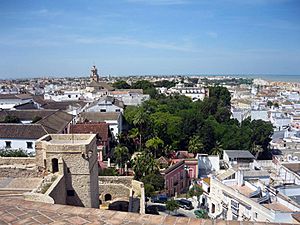
Barrio Alto in Sanlúcar de Barrameda
|
|||
|
|||
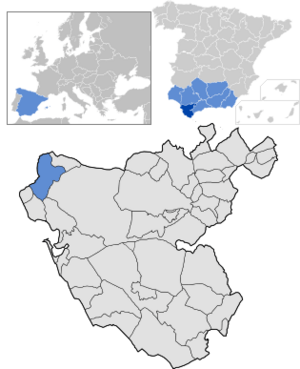
Location of Sanlúcar de Barrameda
|
|||
| Country | |||
| Autonomous community | |||
| Province | Cádiz | ||
| Comarca | Costa Noroeste de Cádiz | ||
| Area | |||
| • Total | 170.93 km2 (66.00 sq mi) | ||
| Elevation | 30 m (100 ft) | ||
| Population
(2018)
|
|||
| • Total | 68,037 | ||
| • Density | 398.040/km2 (1,030.92/sq mi) | ||
| 68,656 | |||
| Demonym(s) | sanluqueño/a | ||
| Time zone | UTC+1 (CET) | ||
| • Summer (DST) | UTC+2 (CEST) | ||
| Postal code |
11540
|
||
| Dialing code | 956 | ||
| Official language(s) | Spanish | ||
Sanlúcar de Barrameda, often called just Sanlúcar, is a city in southern Spain. It is located in the Cádiz province, which is part of the Andalucía region. Sanlúcar sits right at the mouth of the Guadalquivir River. Across the river, you can see the famous Doñana National Park. The city is about 52 kilometers from Cádiz and 119 kilometers from Seville. In 2019, about 68,656 people lived there.
Sanlúcar has been a home for people since ancient times. It might have even been part of the old Tartessian civilization. In 1297, the town was given to a Spanish nobleman named Alonso Pérez de Guzmán.
Because of its great location, Sanlúcar became a very important starting point for exploring and settling America between the 1400s and 1600s. The city's importance changed after 1645. This was due to several reasons, including a decline in Spain and the main trading office moving to Cadiz in 1717.
In the 1800s, Sanlúcar's economy changed. It started focusing on growing grapes for wine and attracting summer tourists. In 1973, Sanlúcar was named a Cultural Historical-artistic site. Today, Sanlúcar is a popular summer spot. It is known for its delicious food, especially a type of sherry wine called manzanilla, and fresh prawns. It is also famous for its unique beach horse racing and lively flamenco music.
Contents
What's in a Name?
The names "Sanlúcar" and "Barrameda" have interesting possible origins. Experts are not fully sure where they come from, but here are some ideas:
- "Sanlúcar" might come from an Arabic word, šurūq. This word means the Levant wind, also known as sirocco.
- The name "Barrameda" might come from an Arabic phrase, bar-am-ma'ida. This means "water well of the plateau."
Where is Sanlúcar?
Sanlúcar de Barrameda is on the Atlantic coast of Andalusia. It is on the left side of the Guadalquivir River's mouth. This river separates the provinces of Huelva and Seville. The city covers an area of about 174.3 square kilometers and has 6 kilometers of beautiful beaches.
Sanlúcar is part of a popular tourist area called the Costa de la Luz, or "Coast of the Light." It is about 44 kilometers from the city of Cádiz. The area includes marshes and is close to the Doñana Natural Park.
A Look Back in Time
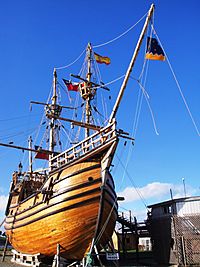
In 1264, King Alfonso X of Castile took Sanlúcar de Barrameda from the Moors. After this, it became a very important port. During the 1400s and 1500s, it was a key place for trade between the Atlantic and the Mediterranean Sea.
When the New World (America) was discovered, Sanlúcar became a busy port for ships. Many Spanish explorers, called conquistadors, started their journeys from here.
- On May 30, 1498, Christopher Columbus began his third voyage to America from Sanlúcar.
- On August 10, 1519, Ferdinand Magellan set sail from Seville with five ships. They traveled down the Guadalquivir River to Sanlúcar. They stayed there for over five weeks before heading out to sea.
- Sanlúcar also saw the return of the last ship from Magellan's expedition in 1522. This ship, the Nao Victoria, was commanded by Juan Sebastián Elcano. It was the first ship ever to sail all the way around the world!
Another important expedition that left from Sanlúcar was to Florida on June 17, 1527. Only four people survived this journey, including Álvar Núñez Cabeza de Vaca. He wrote about his experiences in a book called Naufragios (Shipwrecks).
Cool Places to See
Sanlúcar has many interesting historical places:
- The Castle of Santiago: This castle was built in the 1400s.
- The palace of the Infantes of Orleans and Borbón: This beautiful palace is now used as the City Hall.
- Church of Nuestra Señora de la O: A historic church.
- The palace of the dukes of Medina Sidonia: This palace now holds important historical documents.
- The Convent of Santo Domingo: A building from the 1500s.
- Las Covachas: Another interesting historical site.
Fun and Culture
Sanlúcar de Barrameda is one of the three main towns in Spain that produce sherry wine. The other two are Jerez de la Frontera and El Puerto de Santa María.
Even though it's a seaside town, Sanlúcar is famous for its horse races. These are the oldest horse races in Spain and some of the oldest in Europe! The races happen every August right on the beach at sunset. Thousands of people come to watch. The horses race distances of 1500 and 1800 meters, and the riders wear special colorful outfits.
Other fun events in Sanlúcar include:
- The Sanlúcar Tapas Fair: A competition for local food.
- The Feria de la Manzanilla: A festival in late May celebrating the local sherry wine.
- Classical and jazz music festivals.
- The Romería de El Rocío pilgrimage: A very popular religious journey for Roman Catholics.
Sanlúcar has also always loved bullfighting. Several famous bullfighters have come from this city.
People and Their Work
Historically, people in Sanlúcar mostly worked in farming and fishing. Farmers grew grapes for wine, and fishermen caught the famous Sanlúcar prawns.
- People living near the sea, in an area called Bajo de Guía, were mostly fishermen. Now, many of them also run restaurants that serve fresh seafood.
- People living higher up from the sea, in the Barrio Alto, used to be only farmers. Now, with modern machines, fewer people are needed all year. Many farm workers now work mostly during the grape harvest season.
The center of Sanlúcar became a place for businesses. It has a mix of old buildings like monasteries and churches, and newer ones. This area grew in the early 1900s as a place for wealthier families. Sanlúcar was a popular beach resort back then. Today, people in this area are often involved in the local wine business and tourism.
Doñana National Park
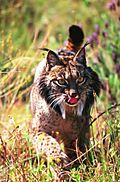
Because Sanlúcar is at the mouth of the Guadalquivir River, it's a great place to start exploring the nearby Doñana National Park (Parque Nacional de Doñana). This park is famous for its amazing wildlife and natural beauty.
Inside the park, you can find the Marisma de Hinojos (Salt Marsh of Fennel Plants). Some people also believe that the legendary lost city of Tartessos might be located within the park's area. Tartessos was an ancient civilization that existed in Iberia even before the Phoenicians arrived.
Images for kids
See also
 In Spanish: Sanlúcar de Barrameda para niños
In Spanish: Sanlúcar de Barrameda para niños



